| In 1856, the cage crinoline was reinvented. The skirts which had previously reached maximum width were free to expand even farther. The hoop was round in shape, somewhat bustled behind. The skirts were made of straight widths of fabric pleated into a waistband.
The jacket bodice also becomes very popular, extending long over the hips. The jacket did not always match the skirt fabric. Evening necklines are off-the-shoulder, and have a point at both front and back. Daytime sleeves are full in Pagoda style, gathered at the top to a narrow shoulder cap, full and/or slit at the wrist, with a linen undersleeve inside. |
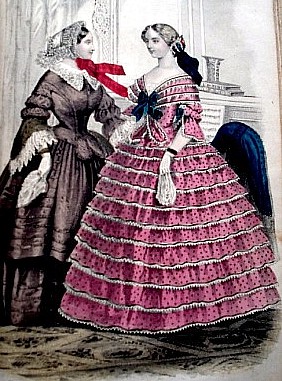 1856 – Grahams |
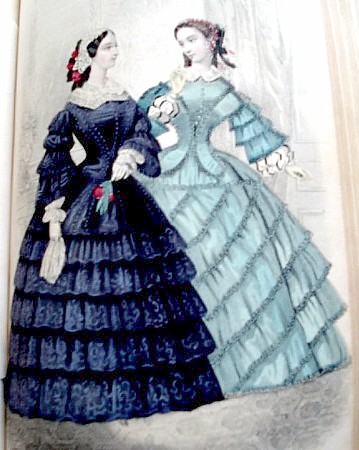 1856 – Grahams |
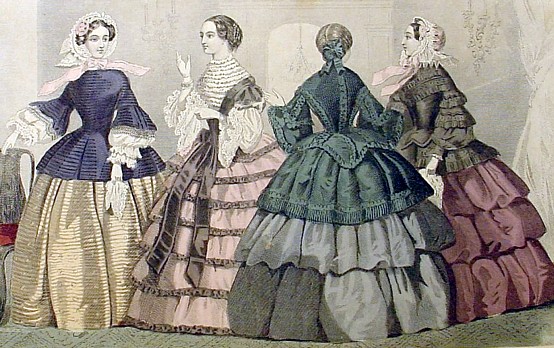 March 1857 – Godeys Magazine. |
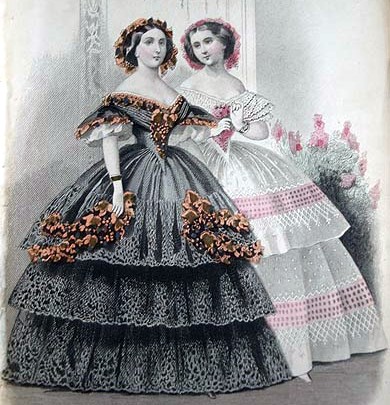 1859 – Perterson Magazine. |
|
By the 1860’s The bodice for casual attire now ends at the natural waist, straight all around, but the formal bodice often has two long points in front and 1 or 3 long points in the back. A new style of casual wear consists of a Spanish jacket, long or cropped, worn over a blouse, aka Garibaldi blouse. In 1860, the front panel of the skirt is very slightly gored. Very quickly, the side panels of the skirt become gored also. Skirts will get narrower at the top every season, and the panels ever more gored. |
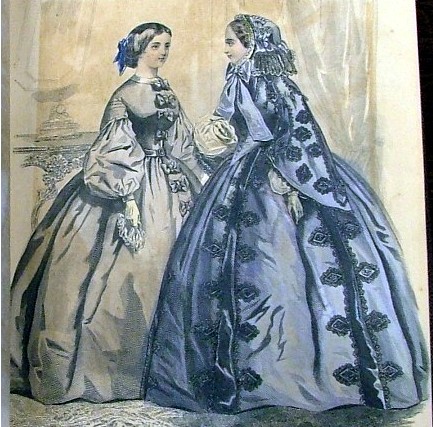 April 1859 – Arthurs Home Magazine |
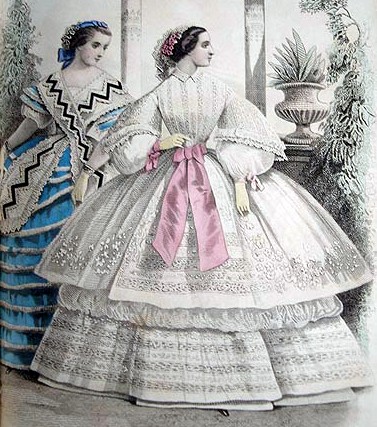 1859 – Petersons Magazine |
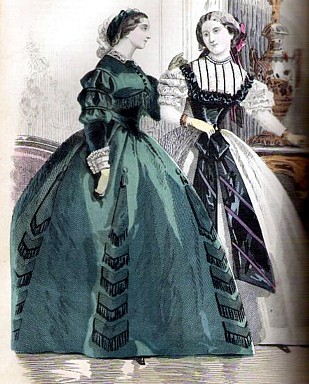 1860 – Petersons |
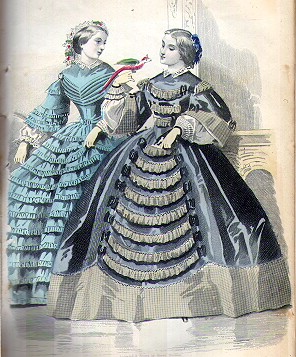 October 1860 – Petersons Magazine. |
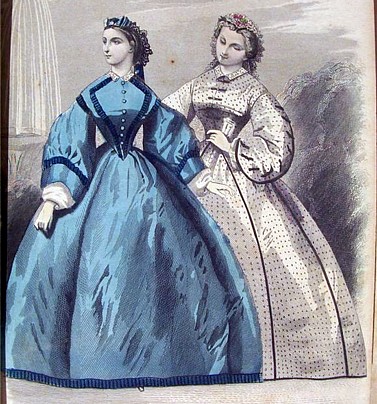 1862 Petersons |
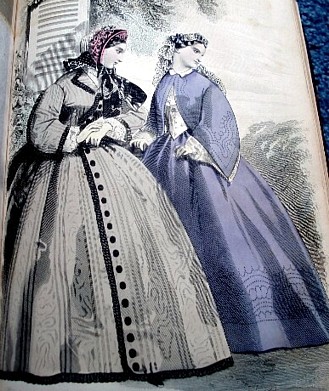 1862 – Petersons |
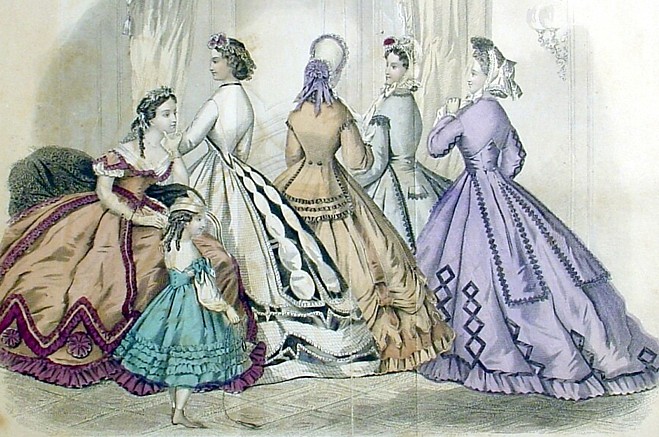 December 1864 – Godeys Ladies Book |
|
| By 1863, the hoops took on an elliptical shape, with the back fuller that the front. The skirts are often gored in the front and sides, the back are still straight breads of fabric. During the Civil War, hardships caused a decline in the amount of fabrics and trimmings used in the dresses. The excessive flounces became fewer and finally disappeared.
In 1864, the 2-piece coat sleeve began to taper at the wrist, and widen at the elbow. The Bishop sleeve, gathered at both wrist and at shoulder, became popular. The bodice ending at the waist became more popular for formal attire. Mr. Worth designed Princess seamed garments. This line was applied to full length dresses as well as outer wear garments. The “postillion bodice”, with long tails down the back are all the rage for a few years. |
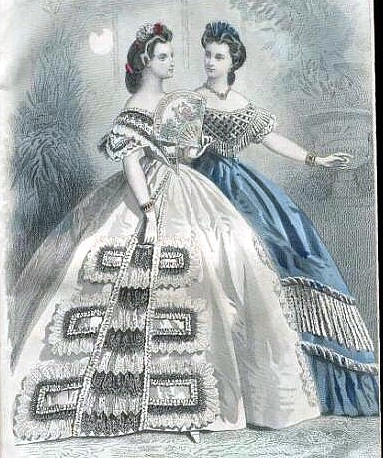 January 1864 – Petersons |
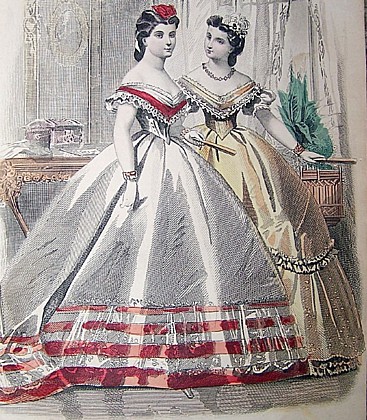 January 1865 – Petersons |
| In 1865 skirt widths began to diminish at the hips, all the panels gored to almost fit the waist, leaving a conical shaped skirt. 1867 saw a reduction in skirt size all together. The skirts were often looped up for walking, showing a pretty petticoat, leading to the introduction of the overskirt. In 1868, skirt backs were once again cut in straight breadths, and by 1869, the hoop is replaced with the bustle. | 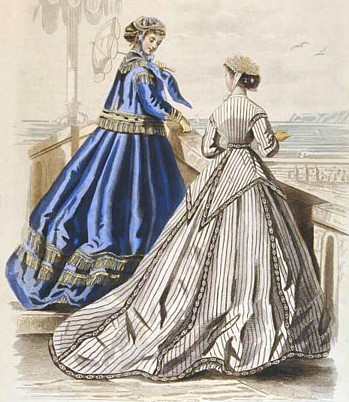 1867 Petite Courrier du Dames |
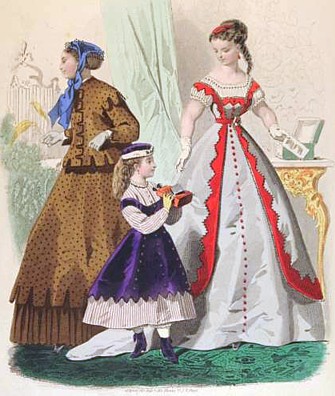 Early 1868 Journal de Demoiselles |
| Petticoats – Early Victorian (pre-1860) petticoats were almost always white. But during the war years, women began to spend more time outside the home. The white petticoats were set aside for indoor and formal/evening wear only. Outdoor petticoats were of colored fabric, either solid or stripes and plaids. Red was a particular favorite color. | Materials used for the petticoats were Camlet, cashmere, flannel, taffeta, rep, quilted silk, and alpaca. Black petticoats (for mourning) of alpaca, llama, lustering, glace.(1861)
“Under the crinolines we recommend the woven woolen petticoat to imitate knitting, made in all colors.” (1863) “A short warm petticoat of wool or flannel, colored or striped, was worn under the crinoline in cold weather. Over the crinoline two white petticoats (the first of cambric with a deep tuck, the second of muslin with a deep flounce, 1863) or one coloured. The day petticoat (except with light summer dresses) was usually coloured, especially scarlet.” By 1862 the white petticoat is usually flounced with frilling and often rows of insertion added. For ball dresses, the flounces would reach as high as the waist. The next year striped and plaid petticoats appear.” For ball dresses and light summer dresses, the crinoline itself would have flounces sewn to each wire. |
The inclusion of the new Steel Hoop into fashion was an effort of the middle class to keep up with high society. Only the rich could afford to purchase and maintain the multitude of petticoats required for such huge dresses. “As to the crinoline, the steel cages, etc., they are not worn in those circles (high society.) They belong to the common people. Starched petticoats are the only ones admitted in high society; if sometimes a “cage” is worn – from a laudable idea of economy – it is emphatically denied.” November 1857. The upper classes finally gave in and began to wear the crinolines, around 1858-1860. |